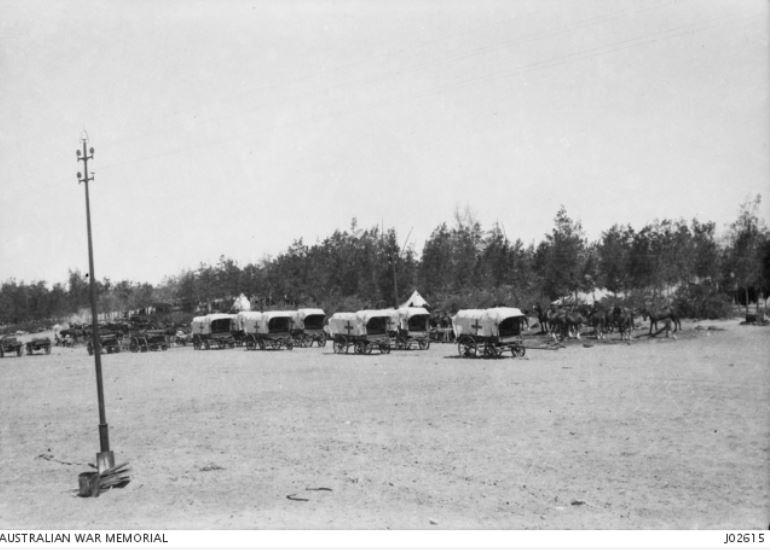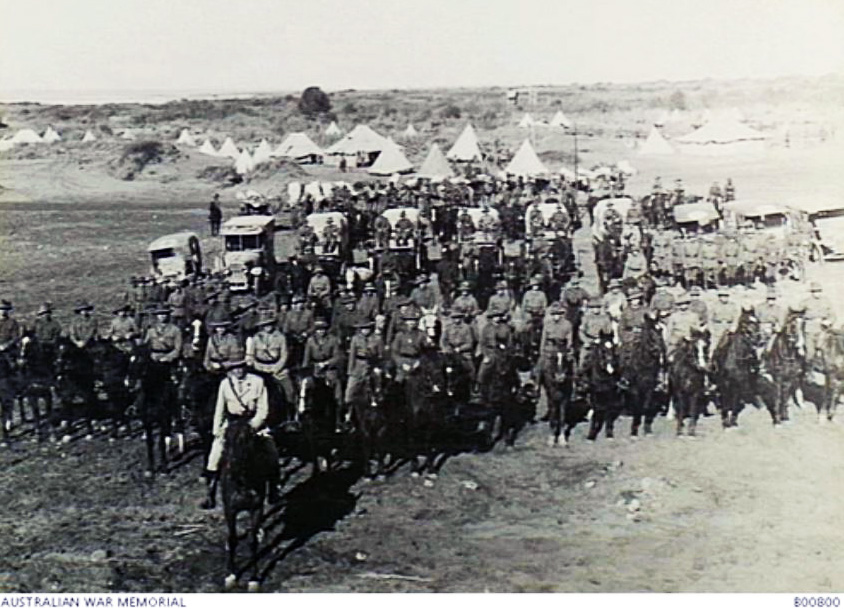3rd Light Horse Brigade Field Ambulance
From Our Contribution
 3rd LHFA park and Horse Lines in the Suez Canal Zone AWM JO2615 | |
 1916 All ranks and Transport of 3rd Light Horse Field Ambulance. AWM B00800 | |
Contents
[hide]Brief History
Formed Queensland 2 October 1914. Departed Brisbane aboard HMAT A51 Chilka on 2 February 1915. Assigned to the Anzac Mounted Division in March 1916. Attached to Imperial Mounted Division February 1917. Assigned to Australian Mounted Division June 1917.
An ambulance consisted of two sections, the Mobile and the Immobile. The Mobile Section travel with its brigade into combat, where it would establish a Dressing Station. It use stretchers or carts to retrieve the wounded and transport them to the Dressing Station. The Immobile Section established and operated a Receiving Station, which received the wounded the Dressing Station sent on. The ambulance's surgeons would operate on the wounded at the Receiving Station. From the Receiving Station, the sick and wounded would go first to the Casualty Clearing Station and ultimately to a Base Hospital.
The light horse field ambulances operated in the Middle East theatre: Egypt, the Sinai peninsula, Palestine and Syria. The methods used to transport the wounded had to operate effectively in the sandy, dusty environment. Methods included:
Stretcher. As in infantry field ambulances, stretchers were used for transport over short distances, rough terrain or when enemy fire prevented the safe employment of bearer animals. Cycle stretcher. These were unpopular and ineffective; after the Gaza battles the forces abandoned the use of cycle stretchers. Sand cart. The mainstay of the transport section was the sand cart. It featured wide steel rims and was designed be able to carry three stretchers over soft sand. Six horses or mules provided the motive power. The sand cart was poorly suited to operating on the hard, rough ground of Palestine and Syria, and breakdowns were frequent. Light ambulance wagon. Drawn by a four horse team, the light ambulance wagon was designed by Surgeon Colonel W.D.C. Williams. Wagons of this type were taken to Egypt by some of the field ambulance units during the early days of World War I. Camel Cacolet. The camel cacolet was used to carry wounded over long distances on rough terrain impassable to wheeled transport. There were two types of cacolet: the sitting and the lying down type. One camel would carry two patients, one on either side of the camel's hump. Eleven men died while posted to this unit, three due to illness.
Patients
1915
- † Hobart Douglas Firns MID 25 - 29 Jun 1915
- Beverley John Liddelow 2 Sep 1915
- Samuel Edward Tate 9 - 12 Oct 1915
- Frederick Thorneycroft Plant 30 Oct - 2 Nov 1915
- William Henry Shade 26 Nov - 1 Dec 1915
1916
- † Charles Franklyn Fuhrmann 11 Jun 1916 - ??
- Amos Roy (Roy) Smith 4 - 9 Jul 1916
- William John Martin (1278) 9 - 15 Jul 1916
- William (George) Lyster 24 Jul 1916
- Francis Leonard Martin 2 days in Aug 1916
- Frank Orlando Dawson 21 - 26 Sep 1916
- William (George) Lyster 26 Nov 2 Dec 1916
1917
- Phillip Selwyn Allen March 1917
- William John Martin (1278) 24 Apr - ?? May 1917
- Archibald Roland Bunney 19 May 1917
- † Charles Franklyn Fuhrmann 19 - 21 Jun 1917
- Walter Cattach 30 Jun 1917
- Edward Harris (Ted) Smith 11 - 18 Jul 1917
- Walter Cattach 20 Jul 1917
- Edward Harris (Ted) Smith 5 - 10 Aug 1917
- Edward Henry Hanrahan 9 - 21 Aug 1917
- Archibald Roland Bunney 16 Nov 1917
1918
- George Ezra Bunney 15 Jan 1918
- Frank Orlando Dawson 8 - 9 May 1918
- Frederick Charles Close 1 Jun 1918
- William John Martin (1278) 7 - ?? Jun 1918
- Archibald Roland Bunney 15 Jun 1918
- Edward Henry Hanrahan 23 Jun 1918
- Edward Harris (Ted) Smith 28 Jun 1918
- Frank Erle Waters 5 Jul 1918
- George Ezra Bunney 12 - 19 Oct 1918
Individual Honours
- 2 x Distinguished Service Order
- 4 x Distinguished Conduct Medal
- 1 x Military Medal
- 15 x Mentioned in Despatches
Notes